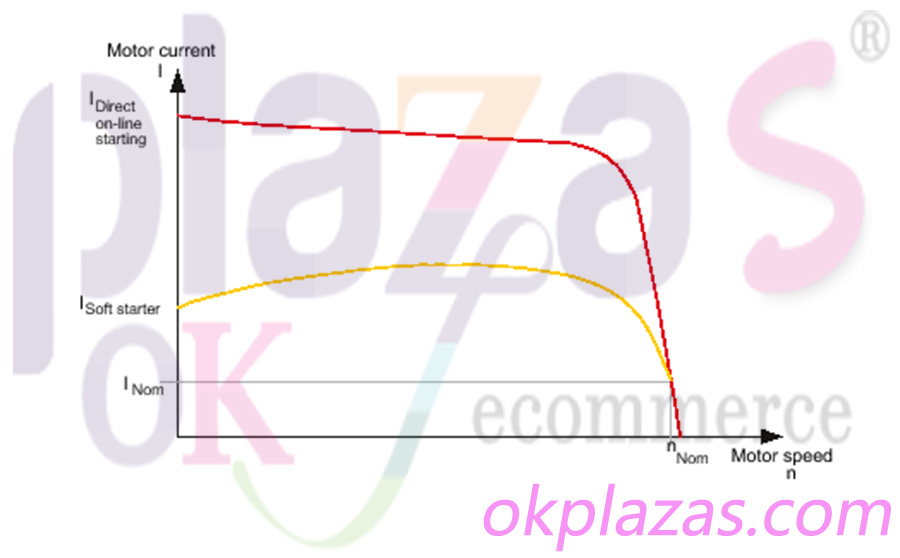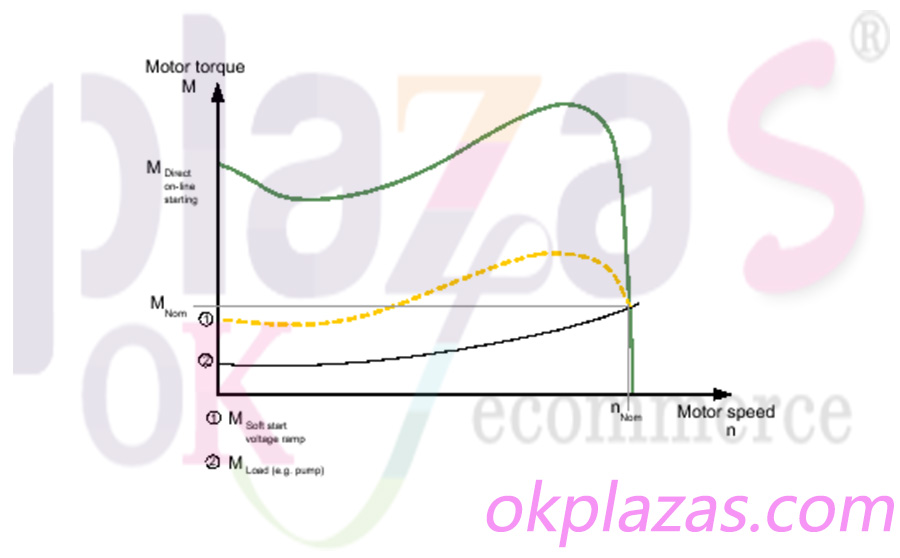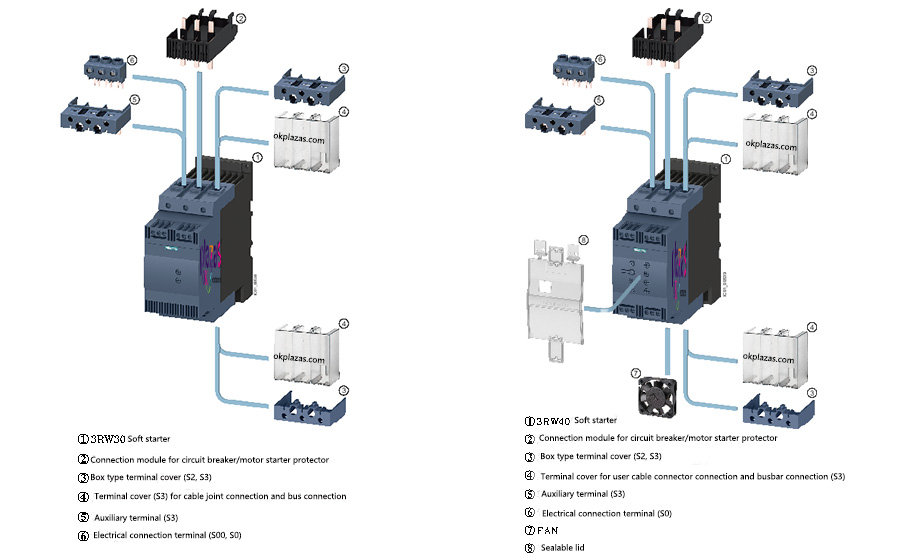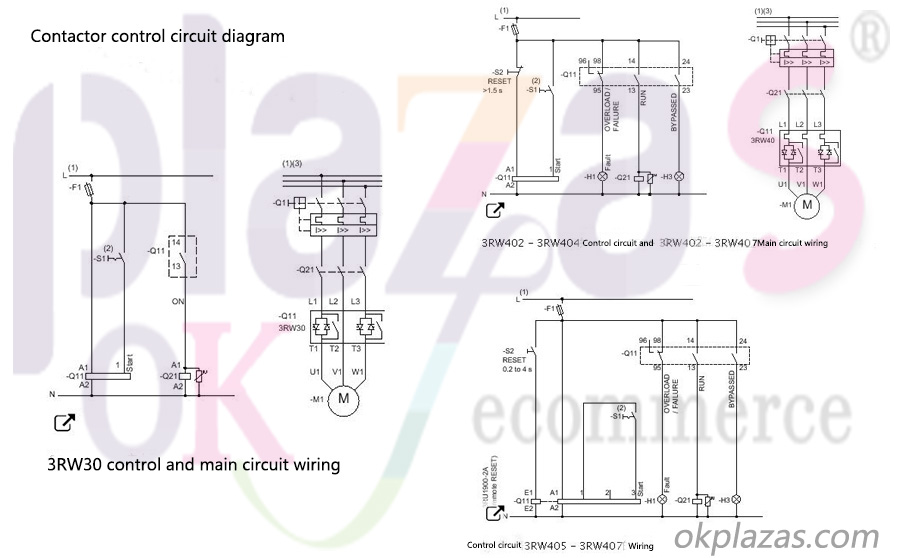Siemens soft starter 3RW30 and 3RW40 instruction manual
Siemens soft starter 3RW30 and 3RW40 instruction manual
Functional principle of Siemens soft starters 3RW30 and 3RW40
Siemens 3RW30 and 3RW40 soft starters have two anti-parallel thyristors in two of the three phases. In each phase, one thyristor for positive half-wave and one thyristor for negative half-wave are provided. The third is not The current in the controlled phase is the sum of the current in the controlled phase.
Siemens soft starters 3RW30 and 3RW40 are controlled by phase angle, and the effective value of the motor voltage is increased (from the settable starting voltage) to the rated motor voltage within a definable starting time. The motor current changes in proportion to the voltage applied to the motor. Therefore the initial current reduces the coefficient of this voltage. There is a quadratic relationship between torque and the voltage applied to the motor. Therefore, the starting torque is reduced in a quadratic manner relative to the voltage.
The following figure shows the starting current and torque characteristics of the combination of a three-phase induction motor and a Siemens soft starter:

When starting with Siemens 3RW30 or 3RW40 soft starter, the current characteristic of the three-phase asynchronous motor is reduced.

When starting with Siemens 3RW30 or 3RW40 soft starter, the torque characteristic of the three-phase induction motor is reduced.
◆Soft start/soft stop principle
This means that since the motor software is controlled by the electronic soft starter during the starting process, it also controls the starting current consumed and the starting torque generated in the motor. The same principle is applied during stopping. This ensures that the torque generated in the motor is gradually reduced, so the application can be stopped smoothly (soft stop function is only supported by 3RW40). During this process, the frequency remains constant and corresponds to the power frequency, contrary to the start and stop of the frequency-controlled inverter.
◆Bypass mode principle
Once the motor is started correctly, the thyristor is fully advanced, which means that the entire supply voltage is applied to the motor terminals. Since it is not necessary to control the motor voltage during operation, the thyristor is bridged by an integral bypass contact rated for AC1 current. This minimizes the waste heat generated during uninterrupted operation (which is caused by the power loss of the thyristor), and minimizes the warming of the switchgear environment.
The bypass contact is protected by the integrated electronic arc extinguishing system during operation. If they are turned on when a fault occurs, for example if the control voltage is temporarily interrupted, mechanical vibration occurs, or the coil operating mechanism or the main contact spring has reached its service life and is defective, and the device is not broken.
The following figure shows the operation method of Siemens soft starters 3RW30 and 3RW40:

Phase angle control and schematic diagram of a two-phase control soft starter with integrated bypass contacts.
Application characteristics of Siemens soft starters 3RW30 and 3RW40
◆Application and selection criteria
Siemens 3RW30 and 3RW40 soft starters are ideal substitutes for direct or star-delta starters. The main features are as follows:
1. Slow start.
2. Soft stop (3RW40 only).
3. Uninterrupted switching and no current peaks cause a heavy burden on the system.
4. Simple installation and debugging.
5. Compact and space-saving design.
◆Application field
1. Conveyor belt.
2. Roller conveyor.
3. Compressor.
4. Water pump.
5. Hydraulic pump.
6. Blender.
7. Circular saw/band saw.
Siemens soft starter 3RW30 and 3RW40 structure

Troubleshooting of Siemens soft starters 3RW30 and 3RW40
◆Siemens soft starter 3RW30 troubleshooting
Fault status 1: Unallowable electronic power supply voltage.
The cause of the failure: the control power supply voltage does not match the rated voltage of the soft starter.
Remedy: Check the control power supply voltage. Power supply failure or voltage sag may cause incorrect control power supply voltage.
Fault state 2: Overload bypass.
Cause of failure: In bypass mode, the current of the soft starter>3.5*Ie>60ms (for example, because the motor is blocked).
Remedy: Check the motor and load, check the size of the soft starter.
Fault status 3: Lack of load voltage, phase loss/missing load.
Fault reason 1: L1/L2/L3 phase is missing at the beginning of soft start, and the motor fails/collapses during operation. If the 3RW30 detects a phase fault at the beginning of the soft start, a trip will occur. At the beginning of the start, the trip time t>0.5s, and no phase fault is detected in the start or bypass mode.
Remedy 1: Connect L1/L2/L3 or correct the voltage dip. Note: Once the motor is in start or bypass mode, these faults will not be detected. In these cases, the Siemens soft starter will not enter a fault state, and contacts 13-14 remain closed.
Cause 2: Connect a motor with insufficient power. If the current flowing through the Siemens 3RW30 soft starter at the beginning of the soft start is less than 10% of the 3RW30 rated working current or less than 1A, a trip will occur.
Remedy 2: Connect a motor with a higher rated working current, or choose a different soft starter. Note: Once the motor is in start or bypass mode, these faults will not be detected. Under these conditions, the soft starter will not enter a fault state, and contacts 13-14 remain closed.
Cause 3: The motor phase T1/T2/T3 is not connected.
Solution 3: Connect the motor correctly (for example, the jumper in the motor junction box, turn off the maintenance switch, etc.).
◆Siemens soft starter 3RW40 troubleshooting
Fault status 1: Unallowable electronic power supply voltage.
The cause of the failure: the control power supply voltage does not match the rated voltage of the soft starter.
Remedy: Check the control power supply voltage, it may be caused by power failure, voltage sag or incorrect control power supply voltage. If due to power fluctuations, please use a stable power supply device.
Fault status 2: Disallowed Ie/CLASS settings and IN (0->1) (control voltage exists, IN start command changes from 0 to 1).
The cause of the failure: the rated working current motor setting (this control voltage, the start command) exceeds the selected level setting.
Remedy: Check the rated operating current set for the motor, choose a lower CLASS setting, or calculate a soft starter with a size margin.
Fault status 3: Motor protection trip overload relay/thermistor.
Cause of failure: The thermal motor model has tripped. After an overload trip, restarting will be prohibited until the end of the recovery time. -Overload relay trip time 60s,-Thermistor trip time After the temperature sensor (thermistor) in the motor cools down.
Remedy: Check whether the rated working current Ie of the motor is set correctly, or change the CLASS setting, or it may reduce the switching frequency, or disable the motor protection (CLASS OFF), or check the motor and application.
Siemens soft starter 3RW30 and 3RW40 installation requirements
The minimum clearances for other equipment must be observed to ensure unobstructed cooling and free supply and exhaust of air to and from the radiator. The installation dimensions, clearance and assembly type of Siemens soft starter are shown in the figure below.

Siemens soft starter 3RW30 and 3RW40 wiring diagram

okplazas.com electromechanical mall is a professional sales agent for Siemens products, welcome to email: [email protected] for consultation, and you can also contact WeChat customer service online at +86-13689242098 for product consultation!





